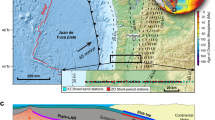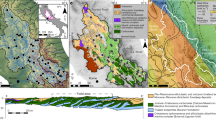Abstract
Squyres et al.1 contend that our proposed volcanic origin for Meridiani Planum2 is inconsistent with more recently obtained data3. But although the new data reveal some variation in chemical composition, this variation is small (Fig. 1a) and mainly due to modest variations in magnesium and sulphur, with concentrations of the other elements remaining essentially constant3. In a volcanic model, this variation can be readily explained by mobilization of highly soluble magnesium sulphate salts during the later stages of alteration and diagenesis (Fig. 1a), as in the sedimentary/evaporite model in which sediments that were initially deposited with uniform composition are subsequently modified3,4,5. Although morphological features in the bedrock may be consistent with aeolian and fluvial origins6, this interpretation is not unique, particularly as features with similar grain size, sorting and morphology are seen in base surge deposits2,7,8,9. Neither chemical nor morphological data therefore preclude a volcanic origin.

Diagrams include data discussed by Squyres et al.1 and typical martian basalts2. a, In a volcanic scenario2, bedrock compositions are attributable to reaction of basaltic ash with sulphuric acid from volcanic vapours. Minor scattering among compositions can be accounted for by mobilization of magnesium sulphate salts in the later stages of alteration (arrows). b, In a sedimentary/evaporite scenario, extrapolation from bedrock compositions to remove sulphate salts would require the original siliciclastic component to be substantially depleted in divalent cations and enriched in Si + Al relative to martian basalt12.
Similar content being viewed by others
Main
Squyres et al. claim1 that their model is misrepresented in our Fig. 1 (ref. 2). However, the apices of the shaded triangle represent not the present composition of the mineral components, but the bulk composition of the potential primary chemical inputs in the sedimentary/evaporite model: a siliciclastic component, sulphate salts precipitated from evaporating groundwater, and iron that may have been mobilized to form haematite. In our Fig. 1 (ref. 2), the composition of the siliciclastic component was represented as basalt, consistent with their descriptions3,4,5,10. Although weathering of silicate minerals is discussed4,5,10, the current mineralogical composition of silicates in the bedrock places no definitive constraints on the chemical composition of the original siliciclastic component; this is because it is inherently unclear whether the current minerals represent primary inputs or secondary alteration products. Consequently, the inferred presence of phyllosilicates and silica4,5,10 cannot be used reliably to constrain the bulk chemical composition of the original siliciclastic input.
Squyres et al.1 suggest that we should have placed one apex of the shaded triangle at the Si + Al end-member (their Fig. 1b), but this is valid only if one of the primary chemical inputs had a bulk composition consisting of just Si + Al. However, the Si:Al ratio is constant throughout Meridiani bedrock3, and both the abundance of SiO2 (48–53% by weight on a sulphur-free basis) and the Si:Al ratio (4.7–5.3) of the bedrocks are nearly identical to martian basalts11 (48–51% by weight SiO2; Si:Al, 3.5–7.2). There is thus no evidence for significant mobilization of Si or Al into the rocks, and Fig. 1b of Squyres et al.1 does not accurately portray primary chemical inputs.
We agree that the current chemical composition of Meridiani bedrock can be accounted for by combining evaporitic and siliciclastic components12. However, this siliciclastic component would have to have been substantially depleted in divalent cations and enriched in Si+Al relative to basalt before it ever interacted with evaporating fluids, not just before it was incorporated into the current outcrop (Fig. 1b). This critical requirement is not discussed in descriptions of the sedimentary/evaporite scenario3,4,5,10, nor has a plausible source for such a large amount of material with this composition been proposed. Furthermore, it would be necessary for evaporating groundwater to add divalent cations to the cation-depleted siliciclastic material in the right proportions to result in their basalt-like chemical compositions12, which seems improbable. The sedimentary/evaporite scenario has significant shortcomings and alternative models2,7 need to be considered.
References
Squyres, S. W. et al. Nature 443, doi:10.1038/nature05212 (2006).
McCollom, T. M. & Hynek, B. M. Nature 438, 1129–1131 (2005).
Clark, B. C. et al. Earth Planet. Sci. Lett. 240, 73–94 (2005).
Squyres, S. W. & Knoll, A. H. Earth Planet. Sci. Lett. 240, 1–10 (2005).
McLennan, S. M. et al. Earth Planet. Sci. Lett. 240, 95–121 (2005).
Grotzinger, J. P. et al. Earth Planet. Sci. Lett. 240, 11–72 (2005).
Knauth, L. P., Burt, D. M. & Wohletz, K. H. Nature 438, 1123–1128 (2005).
Knauth, L. P., Burt, D. M. & Wohletz, K. H. Lunar Planet. Sci. Conf. XXXVII abstr. 1869 (2006).
Burt, D. M., Wohletz, K. H. & Sheridan, M. F. Lunar Planet. Sci. Conf. XXXVII abstr. 2295 (2006).
Squyres, S. W. et al. Science 306, 1709–1714 (2004).
Lodders, K. Meteor. Planet. Sci. 33, 183–190 (1998).
McCollom, T. M. & Hynek, B. M. Lunar Planet. Sci. Conf. XXXVII abstr. 2023 (2006).
Author information
Authors and Affiliations
Corresponding author
Rights and permissions
About this article
Cite this article
McCollom, T., Hynek, B. Bedrock formation at Meridiani Planum (Reply). Nature 443, E2 (2006). https://doi.org/10.1038/nature05213
Published:
Issue Date:
DOI: https://doi.org/10.1038/nature05213
This article is cited by
-
Meridiani Planum sediments on Mars formed through weathering in massive ice deposits
Nature Geoscience (2009)
Comments
By submitting a comment you agree to abide by our Terms and Community Guidelines. If you find something abusive or that does not comply with our terms or guidelines please flag it as inappropriate.



